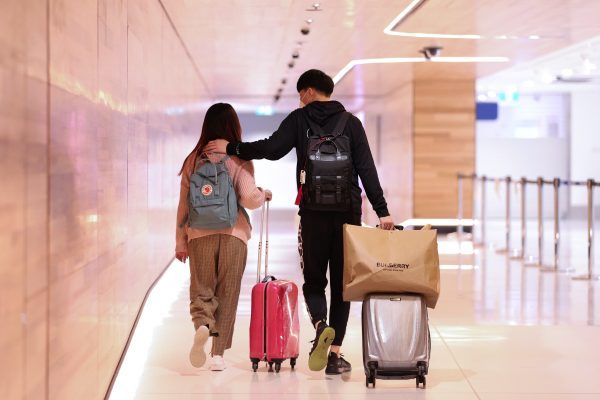Optimising Australia’s COVID-19 border policy

COVID-19 has divided Australia in a manner unprecedented since federation, with the closure of once arbitrary state borders becoming geographical and political fault lines. But Australia’s less-debated international border measures also call for greater scrutiny.
The Australian federal government has been at odds with state governments and openly criticised hard state borders for exacerbating economic disruption, prohibiting domestic tourism and undercutting Australia’s suppression strategy while delivering limited health gains.
Australia’s second most populous state of Victoria has been cordoned off amid a devastating second wave and New South Wales and the Australian Capital Territory have been similarly ring-fenced despite having largely contained the spread of infection.
There are legitimate concerns over state borders that need attention. This includes arrangements for border communities, allowances for low-risk travel and a consistent and streamlined permit process.
The focus on the states, however, neglects Australia’s international border measures which are farthest from optimising health and economic outcomes for all Australians — and state borders have a role in correcting that.
Australia’s international border was closed on 20 March to all but exempt foreign persons and Australians were banned from travelling overseas without approval. Mandatory hotel quarantine on arrival was introduced a week later. These measures were rightly praised for limiting the initial outbreak and necessarily broad and blunt as speed took precedence over finesse.
Almost six months later, Australia has tightened its rules further by introducing arrival caps and hotel quarantine charges. Overseas Australians no longer have an unqualified right to return home and face mandatory accommodation costs that even prisoners aren’t billed for.
The imposition of arrival caps appears exclusively supply-driven, ignoring demand considerations. The official estimate of 23,000 stranded Australians only reflects those who have run into difficulties and sought consular support.
Total international arrivals between April and June were down 98.6 per cent on the same period last year, with long-term resident returns down 82.5 per cent as many were forced to defer. It would take the full 4000-arrivals-per-week quota six months to clear the backlog up to June and accommodate ordinary demand for long-term resident returns alone.
Long-term residents represented just 8.1 per cent of total arrivals between April and June — a proportion at which ordinary demand will never be met. That’s before demand from displaced long-term visitors including international students and migrant workers — critical contributors to the Australian economy — is considered.
Safely accommodating demand for international arrivals requires a significant scaling up of hotel quarantine capacity, a consideration disturbingly absent from the current policy debate. Australia has over 300,000 hotel rooms — excluding properties with fewer than 10 rooms — and there is an inherent trade-off between opening state borders and boosting quarantine capacity.
Domestic tourism may accelerate the circulation of money within Australia but long-term international arrivals add money and business in. The international education sector alone adds US$38 billion a year and migrant workers and returning Australians are essential to filling skills gaps that support local jobs.
Australia’s migration program has long contributed to its international competitiveness and the relative strictness of pandemic borders puts that at risk. Australia’s greatest external economic vulnerability to the pandemic is people movements — not trade, tourism, capital or food security. Excessive barriers to arrivals will hit Australians hardest.
A quarantined arrival — interstate or international — carries a lower transmission risk than an unrestricted domestic traveller. State governments have recognised this in mandating quarantine for interstate visitors. Even if hotel quarantine failings seeded Victoria’s second wave, its rapid community spread reflected the frequency and breadth of interactions within society, not the scale of arrivals.
The unrestricted circulation of people around Australia substantially increases the threat of transmission becoming geographically widespread and difficult to contain, risking not only health but economic calamity as stop–start lockdowns cripple business and consumer confidence.
Add to this the benefit of relocating Australian citizens from global hotspots to comparatively safe Australia and prioritising international arrivals over domestic tourism is a clear winner on health grounds.
The Australian government could take a leaf out of its own pandemic playbook by approaching people movements like trade. Trade beyond and within Australia benefits from there being few restrictions and this has been staunchly defended during the pandemic.
Rather than resorting to formal barriers, governments have implemented heightened safety procedures for goods handling to minimise the risk of virus transmission, achieving a balance between health and economic objectives.
A similar public health-centred approach for people movements focuses on mandatory quarantine and heightened safety procedures for the movement of people. With these central pillars, long-term movements should take precedence while few domestic travellers will accept the cost and inconvenience of quarantine.
A strategy for effectively utilising quarantine centres is imperative — and there is plenty of slack in the hotel sector and underemployed persons to upscale the operation.
A more ambitious operation would build temporary facilities to accommodate arrivals that could later be repurposed as community centres or housing, stimulating construction activity and providing the scale necessary to entice Qantas to assist repatriation efforts.
The debate around state and international borders cannot be separated and a united approach prioritising long-term and essential people movements is optimal in both health and economic terms. State borders that limit tourist movements but facilitate essential lower-risk domestic travel would complement a staggered relaxation of international borders.
Encouraging tourism to fewer places and at shorter distances (within states) can help support essential movements within Australia and enable long-term arrivals to return home and stimulate the economy.
Urgently developing nationally consistent internal borders with streamlined processes and agreed on quarantine exemptions (for border residents, families, medical and work), together with facilitating much greater international arrivals, is what the situation demands.
This article was published by the East Asia Forum.
Stewart Nixon is a research scholar at the Crawford School of Public Policy in the Australian National University. His research interests include foreign investment and migration policy in the Asia-Pacific.













